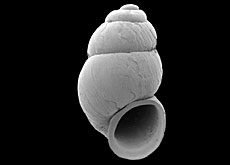How a piece of Africa came to be in Ticino

Millions of years ago a seaside lagoon covered parts of Ticino, leaving its traces behind in the form of marine fossils found at the Monte San Giorgio.
The mountain is regarded as the best place for studying fossil marine life from the mid-Triassic period and is believed to have once been part of Africa. It has been a Unesco World Heritage site since 2003.
More than a thousand metres above sea level, Monte San Giorgio rises like a pyramid on the southern shore of Lake Lugano in the Italian-speaking southern canton of Ticino.
The site is of vital importance for understanding of the fossils and fauna of the mid-Triassic period, 245 to 230 million years ago.
Its Unesco world heritage status is largely down to geologist Markus Felber, who practically drew up the dossier single-handed, investing much of his free time in the project.
As a thank-you for his enthusiasm and commitment, he has had a discovery named after him – the felberia excelsa, the fossil of an unknown species of fish found by two Italian researchers. It is kept in the Cantonal Museum of Natural History in Lugano.
“The Unesco listing is not just a matter of prestige. It also involves scientific responsibilities, including guarantees that research on the site will continue,” said Filippo Rampazzi, the museum’s director.
Seaside lagoon
Scientists believe that Monte San Giorgio’s oldest rocks once belonged to Africa, or at least a part of it known as the Adriatic Plate. “This is why the rocks of Sottoceneri region around Lugano are often associated with the African continent,” Felber explained.
The region was once very different. “The more we dig, the more clues we find to the environmental conditions prevailing in those remote times when San Giorgio was still a seaside lagoon,” explained Rampazzi.
The deciding factor behind Monte San Giorgio’s inclusion onto the Unesco list was in fact the presence of fossil remains showing how, 230 million years ago, a 100-metre deep marine basin was transformed into a sub-tropical region.
Up to now, more than 10,000 fossils have been found in the area, including 30 species of reptile and 80 species of fish.
Research into Monte San Giogio has been carried out for more than 150years by the palaeontology departments of the universities of Zurich and Milan. Most of the finds are housed in Zurich University’s Museum of Palaeontology, while a small number are on display in Meride, a small town close to the site.
Evidence of the past
Monte San Giorgio and its treasures – some discovered, some still hidden – can be reached on foot from two places.
It is a steep and somewhat demanding climb from Riva San Vitale, a village on Lake Lugano. Access is easier from sunny Meride, which is higher up the mountainside.
There is a mule track leading to the summit and, appropriately, its unusual, uneven, surface almost looks like a backbone belonging to some long-forgotten prehistoric animal.
Meride, population 300, has its own Fossil Museum, which opened in the early 1970s. Perhaps the term museum is going a little too far. Situated next door to the town hall, the modest building only has a small plaque informing tourists of the site’s prestigious Unesco status.
“Small but interesting,” reads one entry in the visitors’ book, alongside children’s sketches of dinosaurs. “Difficult to find,” is the well-justified comment of a Dutch couple.
Monte San Giorgio’s most recent fossil discoveries are featured in a documentary – a touch of modernity among the antiquated display cases. An old notice apologises for the state of the exhibition.
There are, however, plans to build a new museum, which is expected to attract 6,500 visitors a year. The work is to be carried out by the internationally renowned Ticino architect Mario Botta.
Not only fossils…
The newly established Monte San Giorgio Foundation will be responsible for coordinating the work of promoting the site, in all its aspects. Several years ago, for example, an association of Monte San Giorgio wine producers was created, as well as a quality label for wines made with grapes from the World Heritage Site area.
Progress has been made outdoors on the mountain too. A trail-marking system has been devised for the mountain’s eight discovery paths.
“To avoid cluttering the paths with signage we have adopted a system based on mp3 readers and CDs. All people need do is download the information from the internet,” said Felber.
The mountain is an important source of stone and quarries were once a main industry in the region. Nowadays only the Arzo quarries and a single quarry at Saltrio, just across the border in Italy are still active.
The region’s stone was much in demand by artists, sculptors and architects working on the building sites of the Italian region of Lombardy. Arzo marble – with its fine colouring and ability to be polished – was famous throughout Europe.
The marble is not only be found in the palaces and churches of Canton Ticino, Lombardy and Piedmont, but also can be seen as far away as Venice and Genoa, Rome and Naples.
Françoise Gehring in Monte San Giorgio, swissinfo.ch
The pyramid-shaped, wooded mountain (1,096m above sea level), to the south of Lake Lugano in Canton Ticino is regarded as the best fossil record of marine life from the Triassic Period (245–230 million years ago).
The sequence records life in a tropical lagoon environment, sheltered and partially separated from the open sea by an offshore reef. Diverse marine life flourished within this lagoon, including reptiles, fish, bivalves, ammonites, echinoderms and crustaceans.
Because the lagoon was near to land, the fossil remains also include some land-based fossils including reptiles, insects and plants. The result is a fossil resource of great richness.
Source: Unesco

In compliance with the JTI standards
More: SWI swissinfo.ch certified by the Journalism Trust Initiative










You can find an overview of ongoing debates with our journalists here . Please join us!
If you want to start a conversation about a topic raised in this article or want to report factual errors, email us at english@swissinfo.ch.